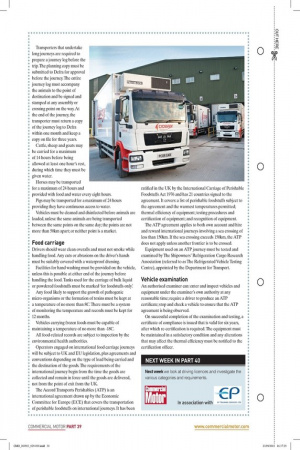Operator CPC Part 39
Page 22

Page 23

If you've noticed an error in this article please click here to report it so we can fix it.
Welcome to week 39 of our Operator CPC study guide. This week we conclude the three-part analysis of vehicle loads with a look at livestock and food transportation
Animal transportation
The Welfare of Animals (Transport) (England) Order 2006 applies to the movement of all vertebrate animals in connection with an economic activity, except: non-commercial activities; transport to/from veterinary clinics under veterinary advice; and individual animals accompanied by owners and fit for the journey.
Pets
Animals that are unfit, very young, pregnant, calves less than 14 days old, or cats and dogs of less than eight weeks old, are banned from transport altogether.
Vehicles used to transport animals must be designed, constructed, maintained and operated so as to avoid injury and suffering and ensure the safety of the animals. All necessary arrangements should be made to minimise the length of the journey and all journeys should be accompanied by documentary evidence of: origin and ownership; place of departure; date and time of departure; intended destination; and expected duration of journey.
Horses, cattle, sheep, goats, and pigs
For journeys of up to 65km (50km for farmers with their own animals in their own vehicles), no additional, special requirements are imposed on the transporter.
For journeys of more than 65km and less than eight hours, Department for Environment, Food and Rural Affairs (Defra)-issued transporter authorisation is required. Authorisation is granted to established businesses that can demonstrate appropriate staff, equipment and operational procedures and have no record of serious infringement of animal welfare legislation in the previous three years. Certificates of competence are required for drivers/attendants.
For journeys of more than 65km and more than eight hours, 'long journey' authority applies (see below), along with the following criteria: valid certificates of vehicle approval; procedures in place to trace and record movement of vehicles and to contact the driver at any time; contingency planning for emergencies; valid certificates of competence for drivers and attendants; sat-nay system for vehicles.
Transporters that undertake long journeys are required to prepare a journey log before the trip. The planning copy must be submitted to Defra for approval before the journey. The entire journey log must accompany the animals to the point of destination and be signed and stamped at any assembly or crossing point on the way. At the end of the journey, the transporter must return a copy of the journey log to Defra within one month and keep a copy on file for three years.
Cattle, sheep and goats may be carried for a maximum of 14 hours before being allowed at least one hour's rest, during which time they must be given water. Horses may be transported for a maximum of 24 hours and
provided with food and water every eight hours.
Pigs may be transported for a maximum of 24 hours providing they have continuous access to water.
Vehicles must be cleaned and disinfected before animals are loaded, unless: the same animals are being transported between the same points on the same day; the points are not more than 50km apart; or neither point is a market.
Food carriage
Drivers should wear clean overalls and must not smoke while handling food. Any cuts or abrasions on the driver's hands must be suitably covered with a waterproof dressing. Facilities for hand washing must be provided on the vehicle, unless this is possible at either end of the journey before handling the food. Tanks used for the carriage of bulk liquid or powdered foodstuffs must be marked 'for foodstuffs only
Any food likely to support the growth of pathogenic micro-organisms or the formation of toxins must be kept at a temperature of no more than 8C. There must be a system of monitoring the temperature and records must be kept for 12 months.
Vehicles carrying frozen foods must be capable of maintaining a temperature of no more than -18C.
All food-related records are subject to inspection by the environmental health authorities.
Operators engaged on international food carriage journeys will be subject to UK and EU legislation, plus agreements and conventions depending on the type of load being carried and the destination of the goods. The requirements of the international journey begin from the time the goods are collected and remain in force until the goods are delivered, not from the point of exit from the UK. The Accord Transports Perishables (ATP) is an international agreement drawn up by the Economic Committee for Europe (ECE) that covers the transportation of perishable foodstuffs on international journeys. It has been
ratified in the UK by the International Carriage of Perishable Foodstuffs Act 1976 and has 21 countries signed to the agreement. It covers: a list of perishable foodstuffs subject to the agreement and the warmest temperatures permitted; thermal efficiency of equipment; testing procedures and certification of equipment; and recognition of equipment.
The ATP agreement applies to both own account and hire and reward international journeys involving a sea crossing of less than 150km. If the sea crossing exceeds 150km, the ATP does not apply unless another frontier is to be crossed.
Equipment used on an ATP journey must be tested and examined by The Shipowners' Refrigeration Cargo Research Association (referred to as The Refrigerated Vehicle Testing Centre), appointed by the Department for Transport.
Vehicle examination
An authorised examiner can: enter and inspect vehicles and equipment under the examiner's own authority at any reasonable time; require a driver to produce an ATP certificate; stop and check a vehicle to ensure that the ATP agreement is being observed.
On successful completion of the examination and testing, a certificate of compliance is issued that is valid for six years, after which re-certification is required. The equipment must be maintained in a satisfactory condition and any alterations that may affect the thermal efficiency must be notified to the certification officer.







































